Setting Up a WebFOCUS Environment in Developer Studio
A WebFOCUS environment consists of a web
server, a WebFOCUS Client, and WebFOCUS Reporting Servers. To add
a WebFOCUS environment, specify a web server containing the WebFOCUS
Client and the connection path it uses. Developer Studio then connects
to the WebFOCUS Client to obtain information on the WebFOCUS Reporting Servers
that the WebFOCUS Client can access.
Add new and edit existing WebFOCUS environments
in Developer Studio using the WebFOCUS Environment Properties dialog
box or the Explorer tree. Use either of these approaches to create
and manage additional environments, for example, test and production
environments.
Note: Developer Studio 8 can only
be used against WebFOCUS 8 or higher. You cannot connect to previous
WebFOCUS releases. If you try to connect to a previous WebFOCUS
release, you will be presented with a message.
x
Working With Environment Properties in
Developer Studio
When you set up access to WebFOCUS environments,
your settings are retained when you restart or reinstall Developer Studio. WebFOCUS environment settings are normally stored in
the following files:
For Windows
XP and Windows 2003 Server:
drive:\Documents and Settings\user_id\Application Data\
Information Builders\wfscom.xml
For Windows 7:
drive:\Users\user_id\AppData\Roaming
Information Builders\wfscom.xml
where:
- user_id
Is your logged on Windows ID.
Note:
- This file and directory
may not be visible by default. To see this directory, open Windows
Explorer, click Tools, choose Folder
Options, and select the View tab.
Then, select Show hidden files and folders and
click OK.
- If an existing wfscom.xml
file has a localhost environment, the existing localhost environment
is updated with settings based on the selected installation and configuration
options. If localhost did not exist, it is created with settings
based on the selected installation and configuration options.
- User IDs and passwords
stored in wfscom.xml are encrypted to keep them confidential.
- WebFOCUS
environment properties
apply to your current Developer Studio configuration and do
not impact other users or the WebFOCUS configuration.
x
Procedure: How to
Add a WebFOCUS Environment
-
Select the File menu
and choose Show Environments.
The Environments List dialog box opens, as shown in the
following image.
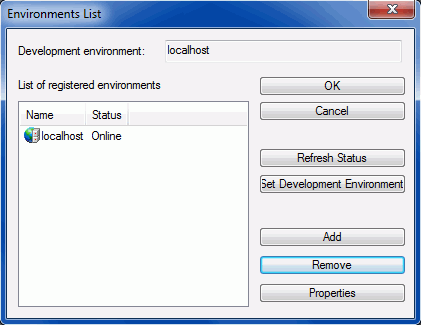
This
dialog lists all of the WebFOCUS Environments
already defined for Developer Studio, if previously installed. If
not installed, only the localhost environment exists. To edit an
existing environment, select it and click Properties.
Note: The Set Development Environment
button does not pertain to Managed Reporting and is only used for
a self-service deployment application.
-
Click Add.
The WebFOCUS Environment
Properties dialog box opens, as shown in the following image.
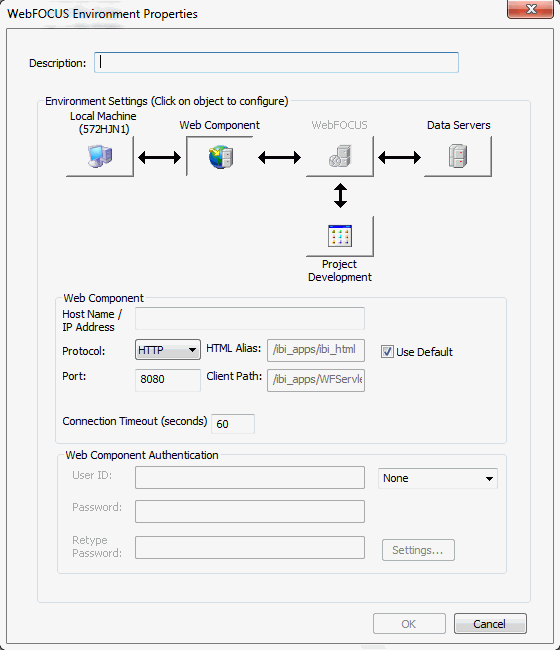
At
the top of the dialog box is the Description field, followed by
the Environment Settings area, where you will find up to six selectable objects. At
the bottom part of the dialog box are two areas, Web Component and
Web Component Authentication. In the Web Component area, you can enter the IP Address (Host Name),
select the Protocol type, enter the Port number information, supply
an HTML Alias, enter the Client Path information, and enter the
Connection Timeout information. In the Web Component Authentication
area, you can enter user ID and password information when the User
ID drop-down list is set to a value other than None.
Note: To work against a remote
WebFOCUS Environment that is configured with IWA security, select IWA as
the Web Component Authentication method.
Use the WebFOCUS Environment Properties
dialog box to define which components make up the environment. You
can optionally enter authentication information for components that
require logon credentials.
-
At the top
of the window, type a description for the environment. This description
will appear in the Explorer under WebFOCUS Environments.
As shown in the following image, the Environment Settings
area contains a series of buttons that each represent a component
in the environment.

The
Web Component button is selected by default. Note
that the Project Development Environment Settings are only available
in the full edition of Developer Studio.
-
At the bottom
of the Web Environment Properties page, specify the information
needed to access the web server.
For some environments, after you specify the web server,
all other options are set by default. If the WebFOCUS environment
you are accessing does not use default settings or the components
require authentication, click the appropriate button in the top
area to provide parameters. The areas that follow explain the parameters
available for each component.
Note: WebFOCUS environment
properties must be supplied in a particular order. For example,
if web server security is enabled, you cannot set the WebFOCUS Client script name until you have provided valid web
server credentials. Similarly, you cannot retrieve a list of Reporting Servers
until you have provided a valid Client Path. As you select a component
button in the dialog box, Developer Studio ensures that it has
the necessary information before it displays the component properties
in the lower part of the dialog box. If the required information
is not available, you will not be able to proceed to the next component.
xLocal Machine Properties in Developer Studio
Local Machine properties are optional. You can select the Local Machine button
to indicate whether to cache files when accessing the WebFOCUS environment.
The following image shows the WebFOCUS Environment
Caching area of the Environment Properties dialog box. The file
content caching location path is for a Windows 7 machine.

In caching, copies of files or information stored on a remote
machine are temporarily stored on your local Developer
Studio machine. Developer Studio works with the locally stored files. Caching increases
performance because remote machines are not accessed and queried
every time you request information, which is especially useful when accessing
mainframes or when a network connection is slow. Note that caching
should not be used when multiple developers are working with the
same files because the possibility exists that one writer may overwrite
the changes of another writer. By default, caching is not enabled.
Two properties are available:
-
Cache remote directory and file information. This
option caches information about files stored on the WebFOCUS environment. This does not
actually cache files, only information about them. If selected, Developer Studio does not query the Reporting Server every time it
needs a list of files stored on the server.
-
Enable file content caching. This
option caches files normally stored on the server. Developer Studio only retrieves files once and then when you wish
to read or edit them, it uses a cached copy. Be aware that when
you edit a cached file, the edited cached file is returned to the server
and replaces the actual file on the server.
Developer Studio retrieves information and files the first time you
request them and then caches them locally. Developer Studio then uses the cached
copies until it is restarted or when you click the Clear buttons
for each level. You can perform a manual refresh and clear all cache
files by clicking View, then Refresh,
or by pressing F5. Refresh is performed for the area that is selected
in the Explorer when you perform this action.
Note:
- If you create a new
synonym, you must manually perform a refresh to view the new files
in the Developer Studio Explorer when caching is enabled.
- You cannot use the
caching options for the local development environment if the Source
Control feature is enabled.
x
The Web Component button is selected
by default. Web Component properties specify how Developer Studio accesses the web server. The web server must be identified
before any other components. The following image shows the Web Component
area of the WebFOCUS Environment
Properties dialog box.
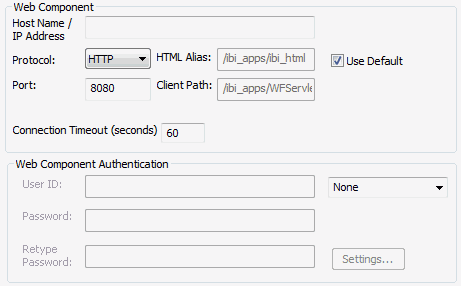
The following properties are available:
-
Host Name/IP Address. Specifies
the host name or IP address where your web server is running. This
field is required and has no default value. For a network installation,
ensure this is the actual host name and not localhost.
-
Protocol. The
protocol to use for accessing the web server (HTTP or HTTPS).
-
Port. The
TCP/IP port for accessing the web server. Port
8080 is the default.
-
HTML Alias. Identifies
the alias used to access content from the WebFOCUS Environment directory,
ibi_html. In WebFOCUS 8, there is no need to configure an ibi_html
alias. The ibi_html content is accessed through the ibi_apps alias. The
configuration of this alias is:
/ibi_apps/ibi_html
where:
- ibi_apps
Is customizable.
- ibi_html
Is constant.
An ibi_html alias
may be required if you have created applications from a previous Developer
Studio release that contains hard coded references to the ibi_html
alias. For these cases, you need to set the HTML Alias as /ibi_html.
For more information on how to configure this alias, see the Developer
Studio Installation and Configuration manual.
-
Client Path. Specifies
how calls are made from Developer Studio to the web server. By default,
when you add a new WebFOCUS environment, it is set to use the WebFOCUS
Servlet with the default ibi_apps context path:
/ibi_apps/WFServlet
where:
- ibi_apps
Is customizable.
- WFServlet
Is constant.
If the WebFOCUS environment
uses a non-default context path, deselect the Use Default check
box and provide the correct Client Path. For example:
/ibi_apps8/WFServlet
If
the Client Path is incorrect for the environment, you receive an
error when you click the WebFOCUS button
at the top of the page or when you press OK to
exit and save your changes. If you do not know your path, ask your
WebFOCUS Administrator or check the WebFOCUS Administration Console
of the environment to which you want to connect. The Client Path
settings for the environment are located under Utilities and Client
Selection.
-
Use Default. Specifies
that the default ibi_html alias is used. Leave
this check box selected, unless you change the HTML Alias value.
Note:
- If the Client Path
field is empty, and the Use Default check box is selected, there
is a problem connecting to the WebFOCUS Client. Ensure your web
server is started and that you typed the correct properties on the
Web Components page. If you cannot connect, contact your WebFOCUS
Administrator.
- If while providing
a custom HTML Alias and Client Path, your connection fails because
of incorrect information and the Client Path is deleted, you can
uncheck Use Default to restore the values
you entered. Click the Use Default check
box to edit the HTML Alias and Client Path, and type the correct
information. If a custom ibi_apps alias or context path is used,
it needs to be entered in both the HTML Alias and Client Path fields.
For example:
HTML Alias:
/ibi_apps8/ibihtml
Client
Path:
/ibi_apps8/WFServlet
-
Web Component Authentication. Used
when authentication is required on the web server. To set security,
select the security method that matches your system from the drop-down
list. A web server user ID, password, and other settings may be
required or enabled, depending on the security method that you select.
By default, this option is set to None, which
means that the web server must allow anonymous access.
Note: ClearTrust, SiteMinder, WebSEAL,
and Oracle Access Manager require templates. Sample templates are
provided with the WebFOCUS product. For more information, see the WebFOCUS
Security and Administration manual.
x
WebFOCUS Properties in Developer Studio
When you click the WebFOCUS button, Developer Studio makes a connection to your web server to retrieve
information about the WebFOCUS environment. Therefore,
you must first specify Web Component properties and your web server
must be running. The following image shows the WebFOCUS area of the Environment
Properties dialog box.
You are prompted to sign in to WebFOCUS
to verify your configuration. You will also be prompted to sign
in to WebFOCUS if you click OK to exit the
dialog box.
Note: Developer Studio will not
display a sign-in dialog box for one minute after a user cancels
out of the dialog box to enter WebFOCUS credentials. This is to
prevent multiple sign-in prompts for a WebFOCUS environment. If
a user needs to reconnect to the WebFOCUS environment for which
they canceled the connection, they need to wait one minute.
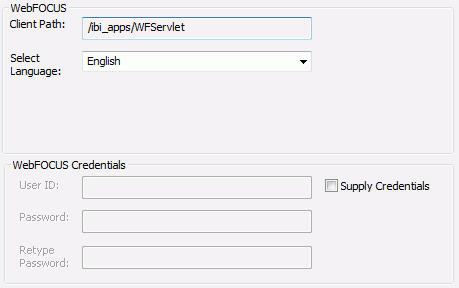
The following properties are available:
-
Client Path. Is
specified in the WebFOCUS Component properties area
and is only available in this pane for reference. This field is
unavailable and can only be changed in the Component properties
area.
-
Select Language. Specifies
the language of the WebFOCUS Client.
-
Supply Credentials. Specifies
whether to supply and store credentials when you connect to WebFOCUS
and access the environment.
When the correct WebFOCUS Client Path is provided,
you can specify properties for the remaining component.
x
You can set authentication and view available Reporting
Servers by clicking the Data Servers button.
When you select Data Servers, WebFOCUS connects to the WebFOCUS Client and retrieves a list
of servers from the communication configuration file (odin.cfg).
The following image shows the Data Servers area of the Environment
Properties dialog box.
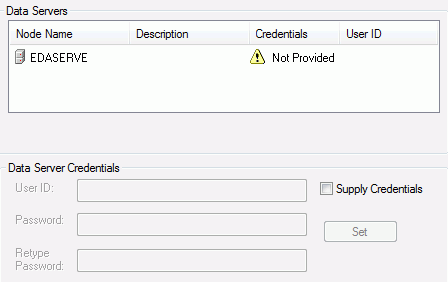
You must be signed in to WebFOCUS to access this window.
The following property is available:
Supply Credentials. If
selected, you can type a user ID and password for the WebFOCUS server
highlighted in the list. Clicking Set stores the
credentials with the environment properties, and the user ID you
supplied is shown next to the server in the list. The Set button
stores your credentials.
xProject Development Properties in Developer Studio
Project development can be optionally configured and
used while working in the Projects area. For more information about
this feature, see Development Modes with Developer Studio.






